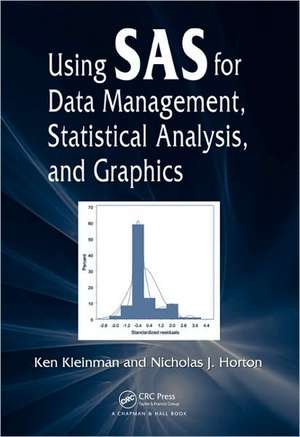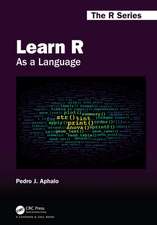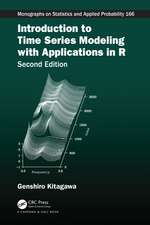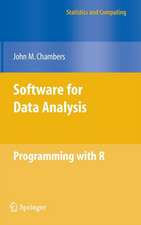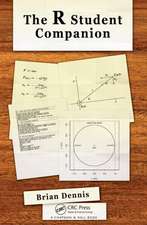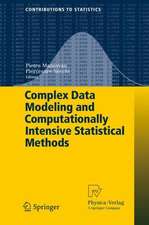Using SAS for Data Management, Statistical Analysis, and Graphics
Autor Ken Kleinman, Nicholas J. Hortonen Limba Engleză Paperback – 28 iul 2010
Includes worked examples across a wide variety of applications, tasks, and graphics
A unique companion for statistical coders, Using SAS for Data Management, Statistical Analysis, and Graphics presents an easy way to learn how to perform an analytical task in SAS, without having to navigate through the extensive, idiosyncratic, and sometimes unwieldy software documentation. Organized by short, clear descriptive entries, the book covers many common tasks, such as data management, descriptive summaries, inferential procedures, regression analysis, multivariate methods, and the creation of graphics.
Through the extensive indexing, cross-referencing, and worked examples in this text, users can directly find and implement the material they need. The text includes convenient indices organized by topic and SAS syntax. Demonstrating the SAS code in action and facilitating exploration, the authors present example analyses that employ a single data set from the HELP study. They also provide several case studies of more complex applications. Data sets and code are available for download on the book’s website.
Helping to improve your analytical skills, this book lucidly summarizes the features of SAS most often used by statistical analysts. New users of SAS will find the simple approach easy to understand while more expert SAS programmers will appreciate the invaluable source of task-oriented information.
| Toate formatele și edițiile | Preț | Express |
|---|---|---|
| Paperback (1) | 621.54 lei 6-8 săpt. | |
| CRC Press – 28 iul 2010 | 621.54 lei 6-8 săpt. | |
| Hardback (1) | 1014.74 lei 6-8 săpt. | |
| CRC Press – 15 noi 2017 | 1014.74 lei 6-8 săpt. |
Preț: 621.54 lei
Preț vechi: 731.22 lei
-15% Nou
Puncte Express: 932
Preț estimativ în valută:
119.00€ • 122.07$ • 100.19£
119.00€ • 122.07$ • 100.19£
Carte tipărită la comandă
Livrare economică 26 februarie-12 martie
Preluare comenzi: 021 569.72.76
Specificații
ISBN-13: 9781439827574
ISBN-10: 1439827575
Pagini: 306
Ilustrații: 32 black & white illustrations, 4 black & white tables
Dimensiuni: 156 x 234 x 16 mm
Greutate: 2.84 kg
Ediția:1
Editura: CRC Press
Colecția CRC Press
ISBN-10: 1439827575
Pagini: 306
Ilustrații: 32 black & white illustrations, 4 black & white tables
Dimensiuni: 156 x 234 x 16 mm
Greutate: 2.84 kg
Ediția:1
Editura: CRC Press
Colecția CRC Press
Public țintă
Professional Practice & DevelopmentCuprins
Introduction to SAS. Data Management. Common Statistical Procedures. Linear Regression and ANOVA. Regression Generalizations. Graphics. Advanced Applications. Appendix. Bibliography. Indices.
Recenzii
This book is a well-organized reference text that summarizes and illustrates SAS code and common SAS features most often used by statistical analysts and others engaged in research and data analysis. … a handy reference tool for common tasks performed in SAS due to the book’s task-oriented nature and the broad range of topics covered. This book would also nicely serve as a supplemental reference text for an introductory SAS programming class.
—Journal of Biopharmaceutical Statistics, Issue 3, 2011
—Journal of Biopharmaceutical Statistics, Issue 3, 2011
Notă biografică
Ken Kleinman is an associate professor in the Department of Population Medicine at Harvard Medical School in Boston, Massachusetts. His research deals with clustered data analysis, surveillance, and epidemiological applications in projects ranging from vaccine and bioterrorism surveillance to observational epidemiology to individual-, practice-, and community-randomized interventions. Nicholas J. Horton is an associate professor in the Department of Mathematics and Statistics at Smith College in Northampton, Massachusetts. His research interests include longitudinal regression models and missing data methods, with applications in psychiatric epidemiology and substance abuse research.
Descriere
This book presents an easy way to learn how to perform an analytical task in SAS, without having to navigate through the extensive, idiosyncratic, and sometimes unwieldy software documentation. It covers data management, descriptive summaries, inferential procedures, regression analysis, multivariate methods, and the creation of graphics. The text includes convenient indices organized by topic and SAS syntax and contains many example analyses. Data sets and code are available for download on the book’s website. New users of SAS will find the simple approach easy to understand while more expert SAS programmers will appreciate the invaluable source of task-oriented information.
